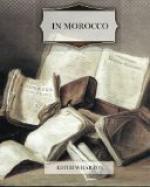It was our first sight of a typical Jewish quarter in Africa. The Mellah of Fez was almost entirely destroyed during the massacres of 1912 (which incidentally included a pogrom), and its distinctive character, happily for the inhabitants, has disappeared in the rebuilding. North African Jews are still compelled to live in ghettos, into which they are locked at night, as in France and Germany in the Middle Ages, and until lately the men have been compelled to go unarmed, to wear black gabardines and black slippers, to take off their shoes when they passed near a mosque or a saint’s tomb, and in various other ways to manifest their subjection to the ruling race. Nowhere else do they live in conditions of such demoralizing promiscuity as in some of the cities of Morocco. They have so long been subject to unrestricted extortion on the part of the Moslems that even the wealthy Jews (who are numerous) have sunk to the habits and appearance of the poorest; and Sefrou, which has come so recently under French control, offers a good specimen of a Mellah before foreign sanitation has lighted up its dark places.
Dark indeed they were. After wandering through narrow and malodorous lanes, and slipping about in the offal of the souks, we were suddenly led under an arch over which should have been written “All light abandon—” and which made all we had seen before seem clean and bright and airy.
The beneficent African sun dries up and purifies the immemorial filth of Africa, where that sun enters there is none of the foulness of damp. But into the Mellah of Sefrou it never comes, for the streets form a sort of subterranean rabbit-warren under the upper stories of a solid agglomeration of tall houses—a buried city lit even at midday by oil-lamps hanging in the goldsmiths’ shops and under the archways of the black and reeking staircases.
It was a Jewish feast-day. The Hebrew stalls in the souks were closed, and the whole population of the Mellah thronged its tunnels in holiday dress. Hurrying past us were young women with plump white faces and lovely eyes, turbaned in brilliant gauzes, with draperies of dirty curtain muslin over tawdry brocaded caftans. Their paler children swarmed about them, little long-earringed girls like wax dolls dressed in scraps of old finery, little boys in tattered caftans with long-lashed eyes and wily smiles, and, waddling in the rear, their unwieldy grandmothers, huge lumps of tallowy flesh who were probably still in the thirties.
With them were the men of the family, in black gabardines and skull-caps, sallow striplings, incalculably aged ancestors, round-bellied husbands and fathers bumping along like black balloons, all hastening to the low doorways dressed with lamps and paper garlands behind which the feast was spread.




